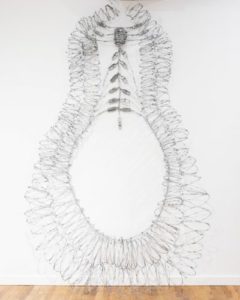“…Only in the mirror inside you can you see outside of yourself,” says British- Israeli artist Yishay Garbasz, holding up this mirror through her career-spanning investigations of trauma, womanhood, and identity. Many artists base their works on victims of “marginalized identity,” a subject that often produces powerful and evocative artwork. Women’s Art Doesn’t End at the Outer Labia is Garbasz’s photographic ode to“marginalized identity” in all its conceptual forms. Garbasz confronts taboos of trauma, memory, and identity—using herself and her past and the locations of historic tragedies as subjects—presenting them boldly with sincerity.
Much of Garbasz’s work focuses on reconceptualizing trauma. “Seeing who I am is only the beginning of my growth as an artist, as my identity has been forged by the trauma I inherited from my mother and her experiences in the Holocaust,” Garbasz says. The continuous narrative of her photography is the multigenerational impact of trauma; her pieces infused with memories of events that she or the viewer may not have experienced firsthand, but that continue to dwell in places and minds—her works a study of these moments’ longitude.
Included in this cross section of her works are pieces pulled from Bearing Witness, a series of projects in which Garbasz captured the aftermath of immense or historic tragedy. This includes Fukushima Prefectural Ono Hospital (2013), a still of an empty hospital taken two years after Japan’s Fukushima Prefecture was devastated by failure of three nuclear reactors. Her landscapes are devoid of life yet somehow buzz with the ghostly imprint of humanity. Garbasz wields memories into tangible subjects, requiring of her viewers a certain patience and care to fully understand the depth of her works.
Emotional disturbance comes first in the layered process of appreciating her works. Viewers can sense the melancholia, the strength of memories. Pieces like Footsteps (40) from In My Mother’s Footsteps (2004-2009) beckon the viewer alongside Garbasz as she traces her mother’s life during the Holocaust. By viewing places from her mother’s harrowing life, viewers are pulled deeper into an exploration of Garbasz evoking true humanity and sincerity. Even without a context of historic events, Garbasz’s works hold the power of memory and emotion. Eat Me Damien (2011) displays Garbasz’s own testicles, preserved in formaldehyde after her gender affirmation surgery. Garbasz invites viewers to experience the deeply personal images that contribute to her identity and memories, to work harder to fully understand her.
Garbasz continues conceptualizing what is “inside” both herself and others. In displaying this variety of photographs together, the message of each collection transforms into a more contemporary idea of identity. She affords the same care and personalization to a still landscape as she does some of her most vulnerable memories. The intertwining of the two suggests that lasting impacts of trauma and memory continue, even in conditions where life’s vibrancy has stopped.
Women’s Art Doesn’t End at the Outer Labia will be on display at Anita Rogers Gallery, 494 Greenwich Street Ground Floor, New York City, through June 18. Visit their website for more information.
By Nikkala Kovacevic



